Abstract
The interaction between human natural killer (NK) cells and yeast cells of Cryptococcus neoformans was investigated because experiments in mice indicated that NK cells inhibited the growth of C. neoformans. Strains of C. neoformans serotype A that differed in both resistance to alveolar macrophages and the size and composition of their capsules were evaluated. Human NK cells, which were isolated from normal peripheral blood, were activated by preincubation with interleukin-2 and alpha interferon to generate lymphokine-activated killer (LAK) cells. Yeast cells of C. neoformans were incubated with effector cells (NK or LAK cells); and inhibition of yeast cell growth was measured at 4, 8, and 24 h by comparing quantitative plate counts with controls consisting of yeasts in the absence of effector cells. The cytolytic activity of effector cells against target cells was confirmed by the release of radiolabel from 51Cr-labeled K-562 tumor cells. Neither NK nor LAK cells inhibited the growth of 13 strains of C. neoformans at effector to target cell ratios of as high as 500:1. Monocytes, which were isolated from the same populations of leukocytes as the NK cells, inhibited the growth of two strains of C. neoformans at effector to target cell ratios of 100:1 (92 and 46% inhibition), 50:1 (87 and 17%), and 1:1 (49 and 0%). NK cells could inhibit the growth of C. neoformans by an antibody-dependent cellular cytotoxicity mechanism in the presence of rabbit anticryptococcal antiserum at dilutions up to 1:4,000. Purified capsular polysaccharide of C. neoformans had no effect on the viability or tumoricidal activity of NK or LAK cells. These data suggest that human NK and LAK cells are not impaired by C. neoformans, and in the absence of antibody, which is rarely detectable in patients, they afford much less protection against C. neoformans than monocytes do.
Full text
PDF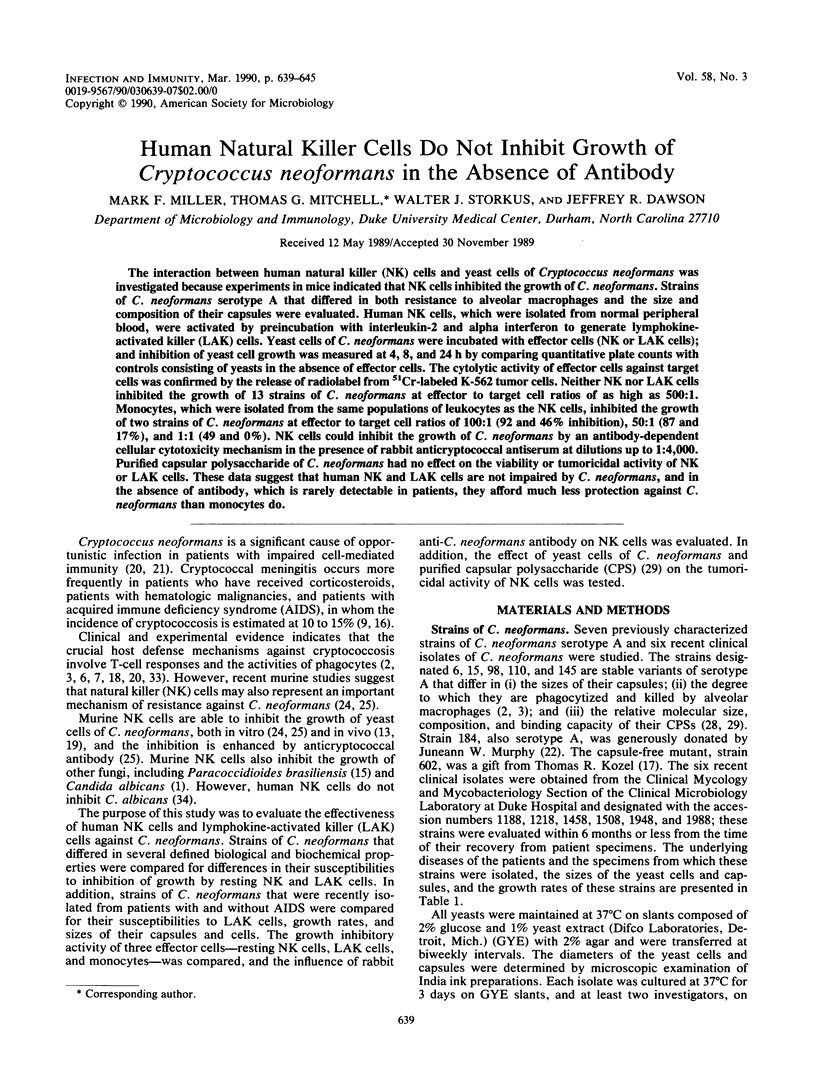
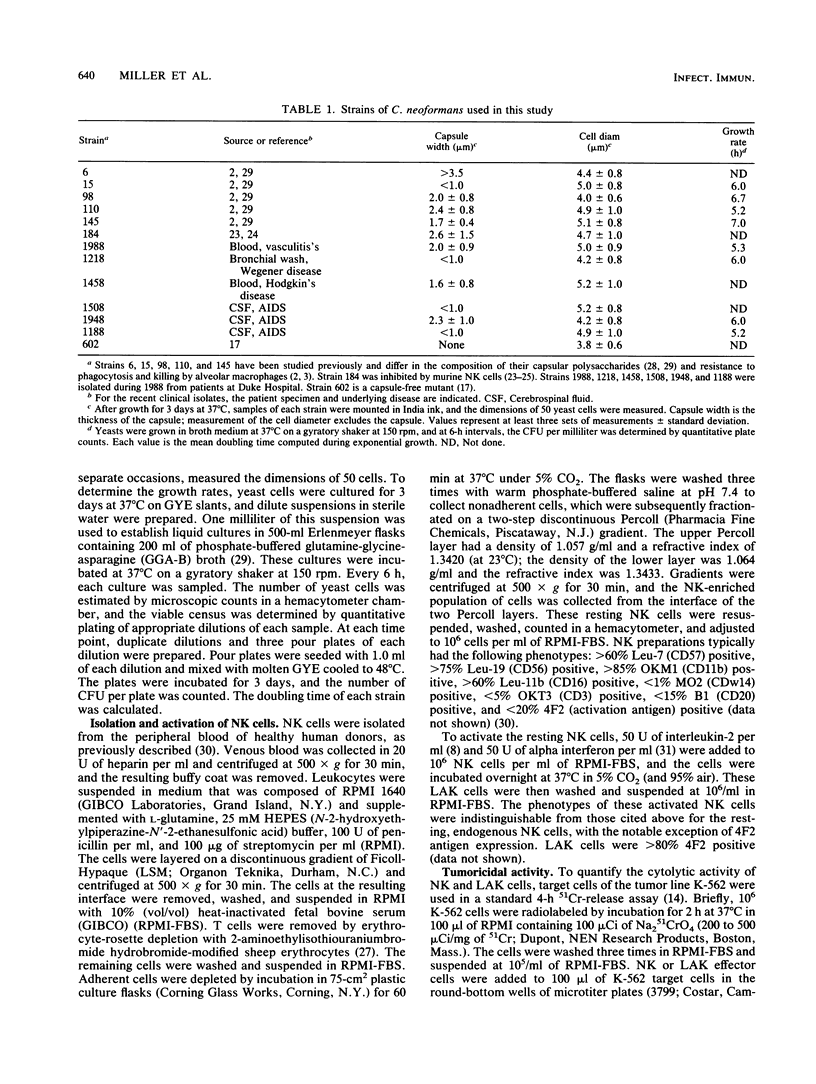
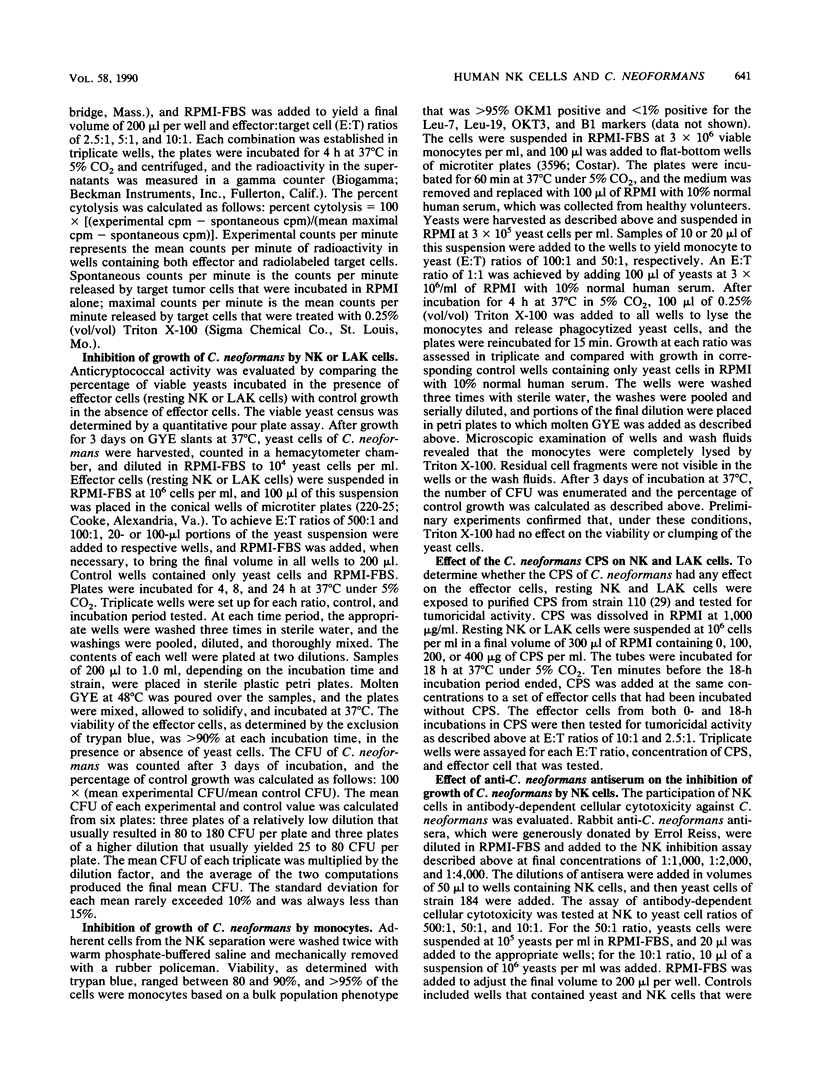
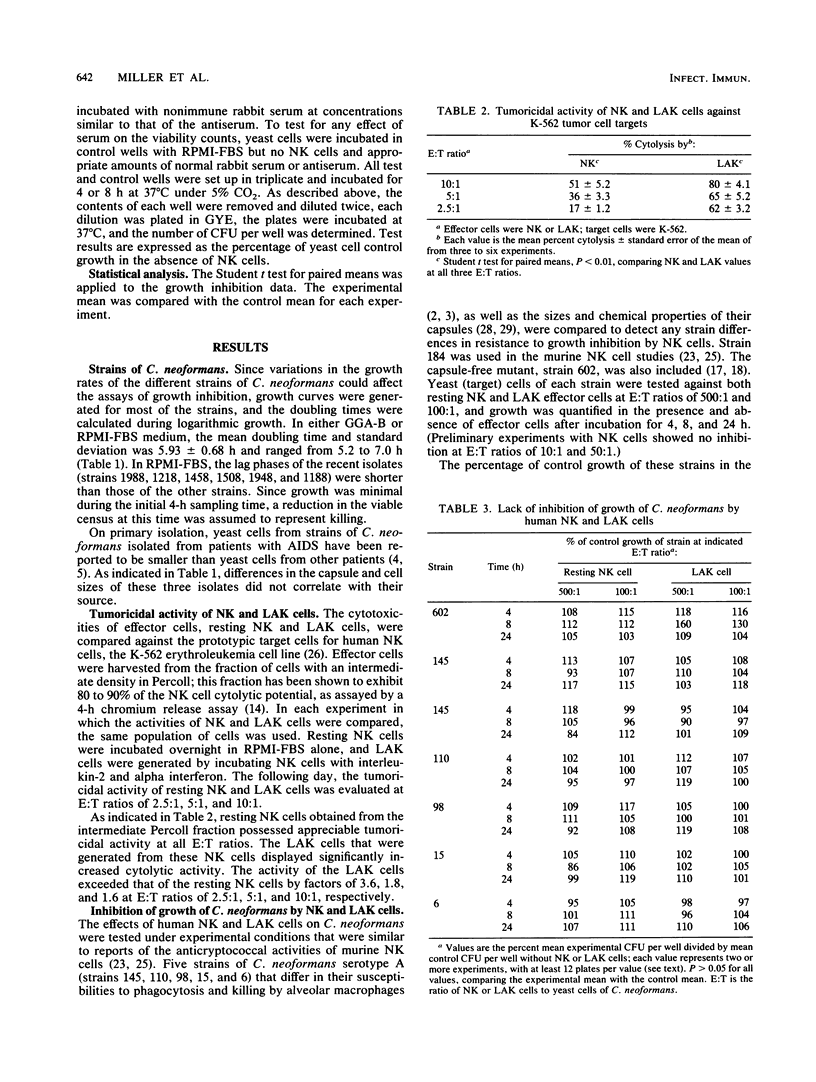

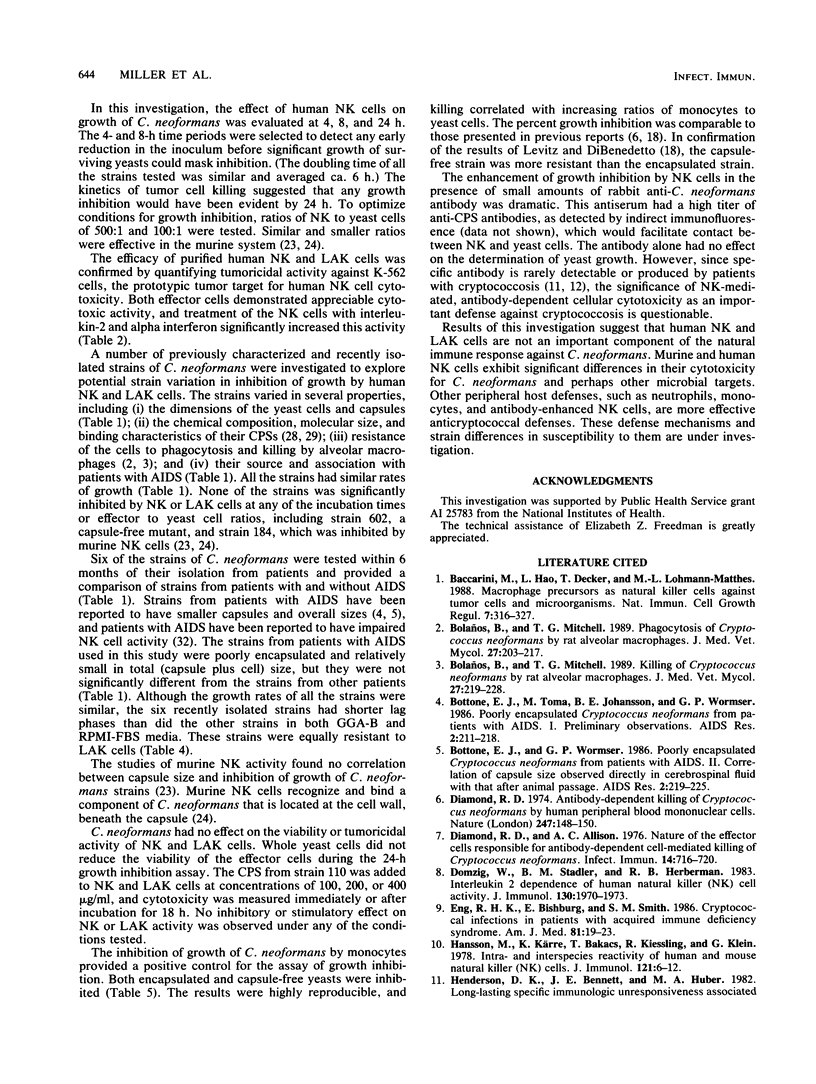
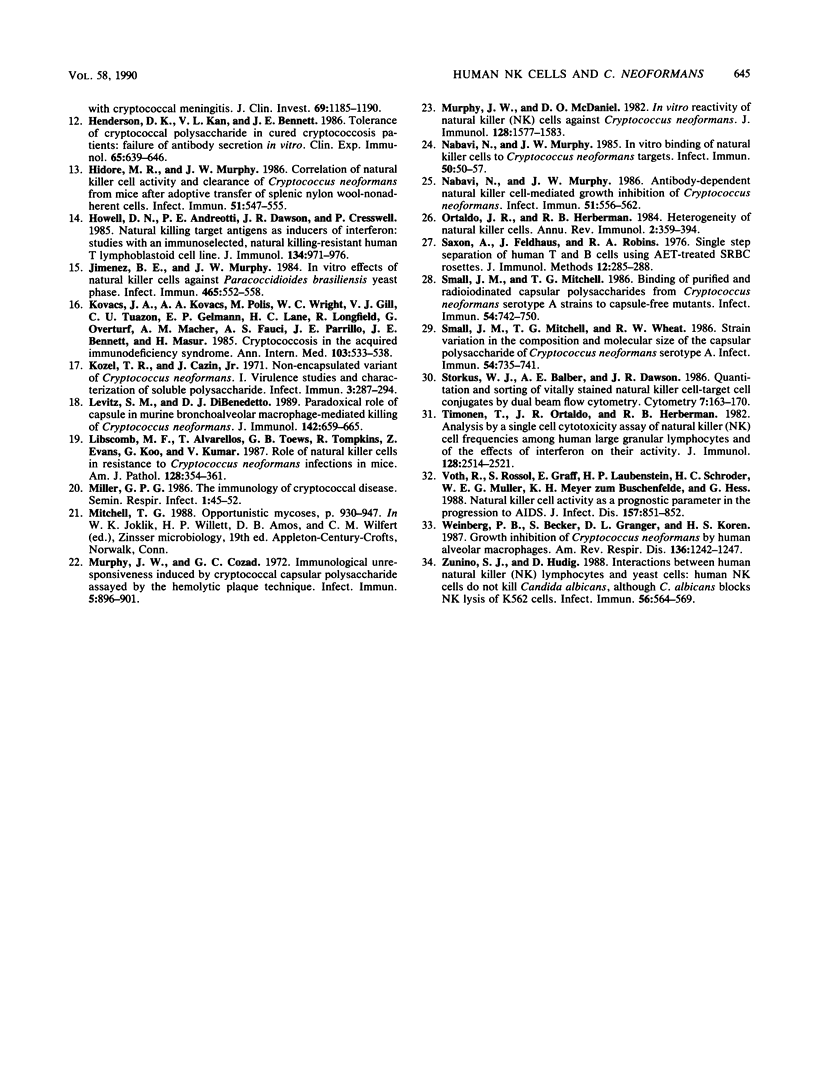
Selected References
These references are in PubMed. This may not be the complete list of references from this article.
- Baccarini M., Hao L., Decker T., Lohmann-Matthes M. L. Macrophage precursors as natural killer cells against tumor cells and microorganisms. Nat Immun Cell Growth Regul. 1988;7(5-6):316–327. [PubMed] [Google Scholar]
- Bolaños B., Mitchell T. G. Killing of Cryptococcus neoformans by rat alveolar macrophages. J Med Vet Mycol. 1989;27(4):219–228. [PubMed] [Google Scholar]
- Bolaños B., Mitchell T. G. Phagocytosis of Cryptococcus neoformans by rat alveolar macrophages. J Med Vet Mycol. 1989;27(4):203–217. [PubMed] [Google Scholar]
- Bottone E. J., Toma M., Johansson B. E., Wormser G. P. Poorly encapsulated Cryptococcus neoformans from patients with AIDS. I: Preliminary observations. AIDS Res. 1986 Summer;2(3):211–218. doi: 10.1089/aid.1.1986.2.211. [DOI] [PubMed] [Google Scholar]
- Bottone E. J., Wormser G. P. Poorly encapsulated Cryptococcus neoformans from patients with AIDS. II. Correlation of capsule size observed directly in cerebrospinal fluid with that after animal passage. AIDS Res. 1986 Summer;2(3):219–225. doi: 10.1089/aid.1.1986.2.219. [DOI] [PubMed] [Google Scholar]
- Diamond R. D., Allison A. C. Nature of the effector cells responsible for antibody-dependent cell-mediated killing of Cryptococcus neoformans. Infect Immun. 1976 Sep;14(3):716–720. doi: 10.1128/iai.14.3.716-720.1976. [DOI] [PMC free article] [PubMed] [Google Scholar]
- Diamond R. D. Antibody-dependent killing of Cryptococcus neopormans by human peripheral blood mononuclear cells. Nature. 1974 Jan 18;247(5437):148–150. doi: 10.1038/247148a0. [DOI] [PubMed] [Google Scholar]
- Domzig W., Stadler B. M., Herberman R. B. Interleukin 2 dependence of human natural killer (NK) cell activity. J Immunol. 1983 Apr;130(4):1970–1973. [PubMed] [Google Scholar]
- Eng R. H., Bishburg E., Smith S. M., Kapila R. Cryptococcal infections in patients with acquired immune deficiency syndrome. Am J Med. 1986 Jul;81(1):19–23. doi: 10.1016/0002-9343(86)90176-2. [DOI] [PubMed] [Google Scholar]
- Hansson M., Bakacs K. K., Kiessling R., Klein G. Intra- and interspecies reactivity of human and mouse natural killer (NK) cells. J Immunol. 1978 Jul;121(1):6–12. [PubMed] [Google Scholar]
- Henderson D. K., Bennett J. E., Huber M. A. Long-lasting, specific immunologic unresponsiveness associated with cryptococcal meningitis. J Clin Invest. 1982 May;69(5):1185–1190. doi: 10.1172/JCI110555. [DOI] [PMC free article] [PubMed] [Google Scholar]
- Henderson D. K., Kan V. L., Bennett J. E. Tolerance to cryptococcal polysaccharide in cured cryptococcosis patients: failure of antibody secretion in vitro. Clin Exp Immunol. 1986 Sep;65(3):639–646. [PMC free article] [PubMed] [Google Scholar]
- Hidore M. R., Murphy J. W. Correlation of natural killer cell activity and clearance of Cryptococcus neoformans from mice after adoptive transfer of splenic nylon wool-nonadherent cells. Infect Immun. 1986 Feb;51(2):547–555. doi: 10.1128/iai.51.2.547-555.1986. [DOI] [PMC free article] [PubMed] [Google Scholar]
- Howell D. N., Andreotti P. E., Dawson J. R., Cresswell P. Natural killing target antigens as inducers of interferon: studies with an immunoselected, natural killing-resistant human T lymphoblastoid cell line. J Immunol. 1985 Feb;134(2):971–976. [PubMed] [Google Scholar]
- Jimenez B. E., Murphy J. W. In vitro effects of natural killer cells against Paracoccidioides brasiliensis yeast phase. Infect Immun. 1984 Nov;46(2):552–558. doi: 10.1128/iai.46.2.552-558.1984. [DOI] [PMC free article] [PubMed] [Google Scholar]
- Kovacs J. A., Kovacs A. A., Polis M., Wright W. C., Gill V. J., Tuazon C. U., Gelmann E. P., Lane H. C., Longfield R., Overturf G. Cryptococcosis in the acquired immunodeficiency syndrome. Ann Intern Med. 1985 Oct;103(4):533–538. doi: 10.7326/0003-4819-103-4-533. [DOI] [PubMed] [Google Scholar]
- Kozel T. R., Cazin J. Nonencapsulated Variant of Cryptococcus neoformans I. Virulence Studies and Characterization of Soluble Polysaccharide. Infect Immun. 1971 Feb;3(2):287–294. doi: 10.1128/iai.3.2.287-294.1971. [DOI] [PMC free article] [PubMed] [Google Scholar]
- Levitz S. M., DiBenedetto D. J. Paradoxical role of capsule in murine bronchoalveolar macrophage-mediated killing of Cryptococcus neoformans. J Immunol. 1989 Jan 15;142(2):659–665. [PubMed] [Google Scholar]
- Lipscomb M. F., Alvarellos T., Toews G. B., Tompkins R., Evans Z., Koo G., Kumar V. Role of natural killer cells in resistance to Cryptococcus neoformans infections in mice. Am J Pathol. 1987 Aug;128(2):354–361. [PMC free article] [PubMed] [Google Scholar]
- Miller G. P. The immunology of cryptococcal disease. Semin Respir Infect. 1986 Mar;1(1):45–52. [PubMed] [Google Scholar]
- Murphy J. W., Cozad G. C. Immunological unresponsiveness induced by cryptococcal capsular polysaccharide assayed by the hemolytic plaque technique. Infect Immun. 1972 Jun;5(6):896–901. doi: 10.1128/iai.5.6.896-901.1972. [DOI] [PMC free article] [PubMed] [Google Scholar]
- Murphy J. W., McDaniel D. O. In vitro reactivity of natural killer (NK) cells against Cryptococcus neoformans. J Immunol. 1982 Apr;128(4):1577–1583. [PubMed] [Google Scholar]
- Nabavi N., Murphy J. W. Antibody-dependent natural killer cell-mediated growth inhibition of Cryptococcus neoformans. Infect Immun. 1986 Feb;51(2):556–562. doi: 10.1128/iai.51.2.556-562.1986. [DOI] [PMC free article] [PubMed] [Google Scholar]
- Nabavi N., Murphy J. W. In vitro binding of natural killer cells to Cryptococcus neoformans targets. Infect Immun. 1985 Oct;50(1):50–57. doi: 10.1128/iai.50.1.50-57.1985. [DOI] [PMC free article] [PubMed] [Google Scholar]
- Ortaldo J. R., Herberman R. B. Heterogeneity of natural killer cells. Annu Rev Immunol. 1984;2:359–394. doi: 10.1146/annurev.iy.02.040184.002043. [DOI] [PubMed] [Google Scholar]
- Saxon A., Feldhaus J., Robins R. A. Single step separation of human T and B cells using AET treated srbc rosettes. J Immunol Methods. 1976;12(3-4):285–288. doi: 10.1016/0022-1759(76)90050-8. [DOI] [PubMed] [Google Scholar]
- Small J. M., Mitchell T. G. Binding of purified and radioiodinated capsular polysaccharides from Cryptococcus neoformans serotype A strains to capsule-free mutants. Infect Immun. 1986 Dec;54(3):742–750. doi: 10.1128/iai.54.3.742-750.1986. [DOI] [PMC free article] [PubMed] [Google Scholar]
- Small J. M., Mitchell T. G., Wheat R. W. Strain variation in composition and molecular size of the capsular polysaccharide of Cryptococcus neoformans serotype A. Infect Immun. 1986 Dec;54(3):735–741. doi: 10.1128/iai.54.3.735-741.1986. [DOI] [PMC free article] [PubMed] [Google Scholar]
- Storkus W. J., Balber A. E., Dawson J. R. Quantitation and sorting of vitally stained natural killer cell-target cell conjugates by dual beam flow cytometry. Cytometry. 1986 Mar;7(2):163–170. doi: 10.1002/cyto.990070207. [DOI] [PubMed] [Google Scholar]
- Timonen T., Ortaldo J. R., Herberman R. B. Analysis by a single cell cytotoxicity assay of natural killer (NK) cells frequencies among human large granular lymphocytes and of the effects of interferon on their activity. J Immunol. 1982 Jun;128(6):2514–2521. [PubMed] [Google Scholar]
- Voth R., Rossol S., Gräff E., Laubenstein H. P., Schröder H. C., Müller W. E., Meyer zum Büschenfelde K. H., Hess G. Natural killer cell activity as a prognostic parameter in the progression to AIDS. J Infect Dis. 1988 Apr;157(4):851–852. doi: 10.1093/infdis/157.4.851. [DOI] [PubMed] [Google Scholar]
- Weinberg P. B., Becker S., Granger D. L., Koren H. S. Growth inhibition of Cryptococcus neoformans by human alveolar macrophages. Am Rev Respir Dis. 1987 Nov;136(5):1242–1247. doi: 10.1164/ajrccm/136.5.1242. [DOI] [PubMed] [Google Scholar]
- Zunino S. J., Hudig D. Interactions between human natural killer (NK) lymphocytes and yeast cells: human NK cells do not kill Candida albicans, although C. albicans blocks NK lysis of K562 cells. Infect Immun. 1988 Mar;56(3):564–569. doi: 10.1128/iai.56.3.564-569.1988. [DOI] [PMC free article] [PubMed] [Google Scholar]


